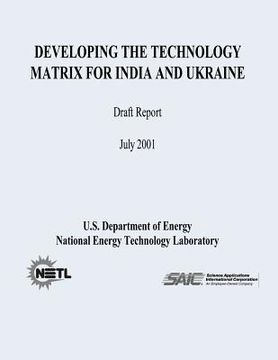Developing The Technology Matrix for India and Ukraine (Draft Report) (in English)
Synopsis "Developing The Technology Matrix for India and Ukraine (Draft Report) (in English)"
Over the last decade, concern about the issues of global climate change and rising greenhouse gas emissions has grown significantly. This concern has spurred an elaborate series of international meetings and agreements seeking to stabilize atmospheric greenhouse gas concentrations. In 1992, at Rio de Janeiro, more than 160 countries, including the United States, signed the United Nations Framework Convention on Climate Change (UNFCCC). The signatories were in agreement regarding the potential negative effects of climate change under a business as usual future. Under the Convention, the developed countries (referred to as Annex I countries) were assigned primary responsibility for addressing the climate change issue. However, at the first two Conferences of Parties1 called to discuss methods for implementing the Convention, a strong debate ensued regarding what policy instruments should be used to curb global climate change, and what, if any, targets and timetables should be set for achieving emission reductions. Most Annex I nations announced a series of voluntary targets and initiatives for meeting emission reduction goals. By 1996, it had become clear that greenhouse gas emission levels in most Annex I countries were rising despite voluntary efforts to reduce emissions. A consensus for firmer targets and timetables was building. At the Third Conference of Parties, held in Kyoto, Japan in December 1997 a series of firm emission reduction targets were agreed to by the Parties. Developed countries agreed to reduce their greenhouse gas emissions by an average of 5.2 percent from 1990 levels by 2008-2012. While the resulting "Kyoto Protocol" was signed in 1997 by the United States and other industrialized countries, it was never ratified by the U.S. Senate, and the Administration recently announced its intention of dropping out of the negotiations surrounding the Protocol. Nonetheless, the general scientific consensus that global warming is a real, significant issue is not in dispute. The Administration is calling into question only the appropriate response to the issue, while explicitly recognizing the need for some response. Regardless of whether this response takes the form of a domestic voluntary program, an international treaty, or something in between these two extremes, it is likely that it will incorporate "market mechanisms" in some form or another. The concept of flexible, market-based mechanisms is an essential element to the Convention and the Kyoto agreement. Market mechanisms are designed to facilitate low-cost solutions to environmental problems. This new concept awards credits for emission reduction activities undertaken beyond a country's borders. In order to estimate emission reductions arising from such market-based emissions reduction projects, the emissions generated by the project itself must be measured and subtracted from some baseline representing what emissions would have been in the absence of the project. The technology matrix, originally proposed by the National Energy Technology Laboratory (NETL) in the report Developing Emission Baselines for Market-based Mechanisms: A Case Study Approach, is a potential method for estimating the baseline. It consists of a selected list of greenhouse gas abating technologies, along with emission rate benchmarks for each technology. In this document, a technology matrix was developed for ten selected technologies, for the countries of India and Ukraine. The basic technology matrix development approach was the same for all of the stated technologies, and for both countries. For a technology to "qualify" for the selected list of greenhouse gas abating technologies, it must first be subjected to a rigorous test to demonstrate that projects utilizing the technology are "additional" to those that would have been implemented under "business as usual" circumstances.

